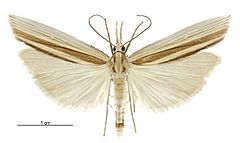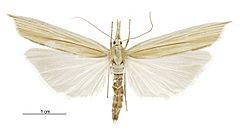Orocrambus angustipennis facts for kids
Quick facts for kids Orocrambus angustipennis |
|
|---|---|
 |
|
| Male | |
 |
|
| Female | |
| Scientific classification | |
| Kingdom: | |
| Phylum: | |
| Class: | |
| Order: | |
| Family: | |
| Genus: | |
| Species: |
O. angustipennis
|
| Binomial name | |
| Orocrambus angustipennis (Zeller, 1877)
|
|
| Synonyms | |
|
|
The Orocrambus angustipennis is a special kind of moth that belongs to the Crambinae family. This moth is unique because it is endemic to New Zealand. This means you can only find it living naturally in New Zealand and nowhere else in the world!
You can spot Orocrambus angustipennis moths across New Zealand. They live on the North Island, the South Island, and even on the Chatham Islands.
Contents
Discovering the Orocrambus Angustipennis Moth
These fascinating moths are part of the huge group of insects called Lepidoptera, which includes all moths and butterflies. The Orocrambus angustipennis is a small but important part of New Zealand's amazing wildlife.
What Does the Moth Look Like?
The Orocrambus angustipennis moth has different sizes for males and females. The males have a wingspan of about 34 to 40 millimeters. This is roughly the length of a small paperclip!
Female moths are a bit larger than the males. Their wingspan can be from 44 to 50 millimeters. This size difference helps scientists tell them apart.
Life Cycle of the Moth
Adult Orocrambus angustipennis moths are active during the warmer months. You can see them flying around from November to March.
These moths have two generations each year. This means that they complete their entire life cycle (from egg to adult) twice within that period. It's like having two sets of moth families born in one season!
What Do the Larvae Eat?
Before they become adult moths, Orocrambus angustipennis start their lives as larvae, also known as caterpillars. These larvae have a very specific diet.
They love to eat plants from the Cortaderia family. This includes well-known types like Cortaderia selloana, which is often called Pampas grass, and Cortaderia toetoe, which is a native New Zealand grass. The larvae are clever eaters; they feed inside the growing stems and blades of these plants. This helps them stay hidden and safe while they grow.

